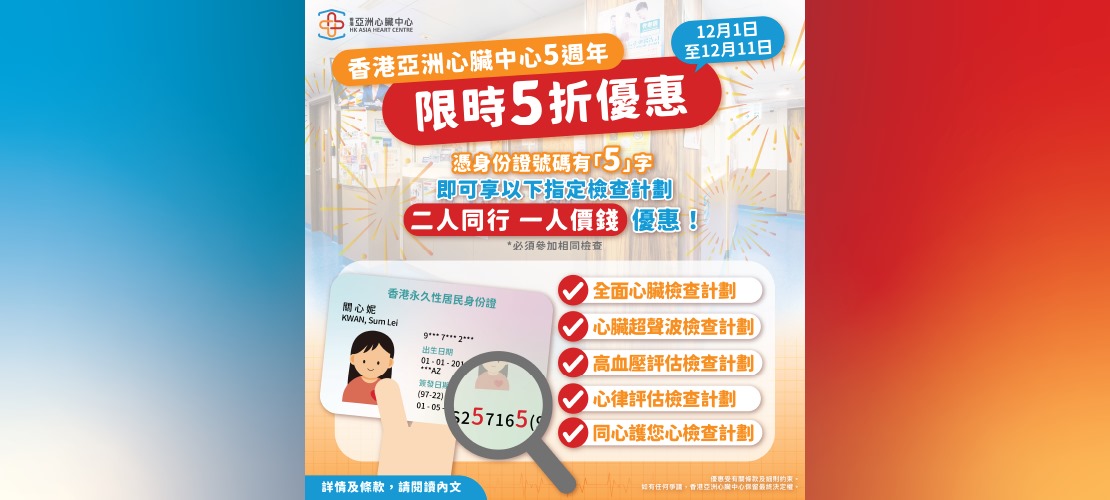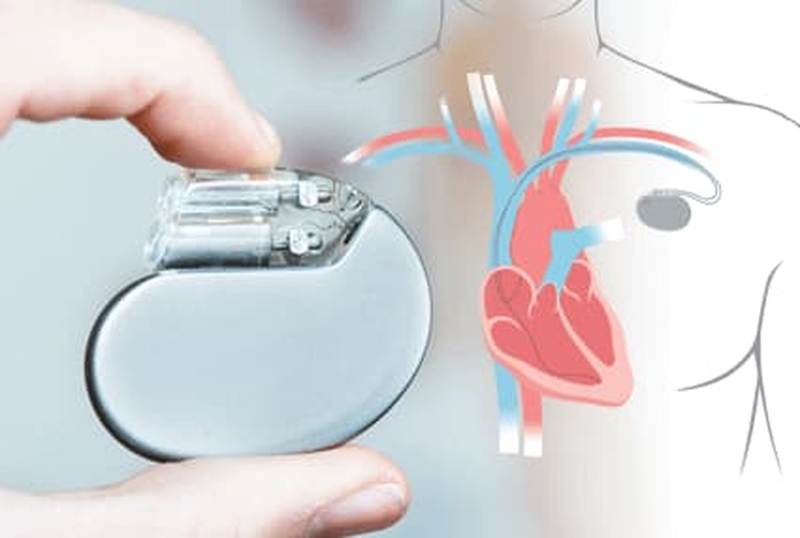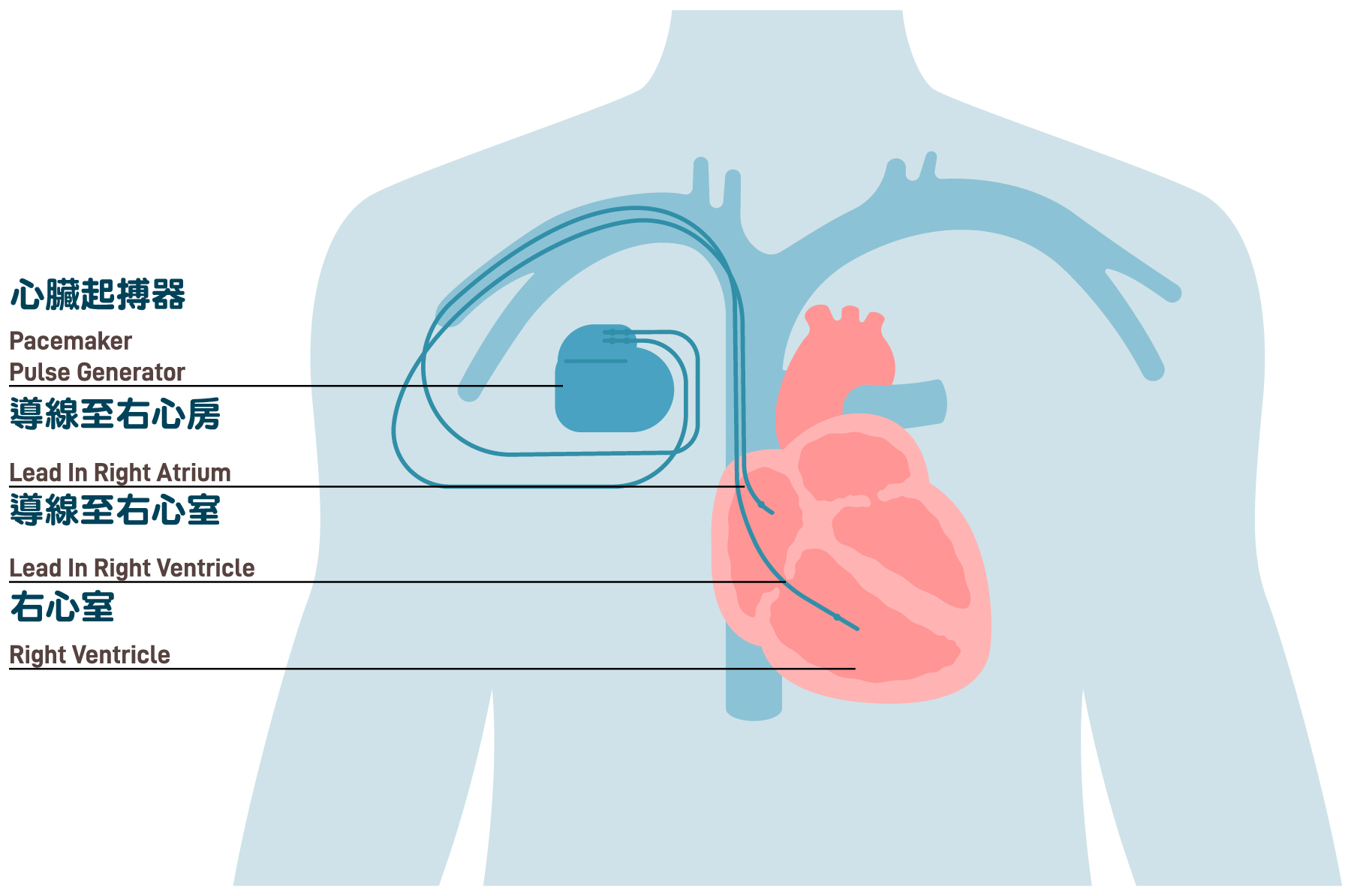Permanent Pacemaker (PPM) | Hong Kong Asia Heart Centre
Heart rhythm is mainly controlled by the conduction system of the heart. Any abnormality in the conduction system may result in abnormal heart rhythm (arrhythmia). Arrhythmias with slow heart rate cause dizziness, syncope, heart failure or occasionally cardiac death.
Permanent cardiac pacemaker (PPM) is an
implantable device used for long-term treatment of arrhythmias with slow heart
rate. It consists of a battery-powered generator and leads which connect the
generator to the patient’s heart. If the heart rate is slow, the pacemaker will
stimulate the heart at a desirable rate.
Proccess:
- This invasive procedure is performed under local anesthesia in the Cardiac Catheterization & Intervention Laboratory (CCIL). You are alert during the procedure, but we may give you sedation to calm you down.
- Electrodes are adhered to the chest to monitor the heart rate and rhythm. Blood oxygen monitor through your fingertip will be set up. Measurement of blood pressure from your arm will be taken during the examination.
- Skin disinfection will be performed and a small skin incision (about 3-5 cm long) will be made under your left (sometimes right) clavicle.
- Contrast may be injected intravenously to visualize the veins in your arm and needle puncture under the clavicle may be required to obtain an access to your vein.
- 1 to 2 leads will be advanced to your heart chambers through your vein under X-ray guidance.
- The generator will be connected with the lead(s) and implanted in a pocket created under the skin or muscle.
- The wound will be closed with suturing material and may covered with pressure dressing.
- The procedure usually takes around 2 to 3 hours.
After Procedure:
- You may be discharged from hospital 1-2 days after the PPM implantation.
- The wound will be inspected and covered with light dressing. Please keep the wound site clean and change dressing if wet. In general, showers are allowed after 7 days.
- You may need to come back to the centre for suture removal 1 week after the procedure. You may remove the dressing 2-3 days after suture removal.
- Please avoid lifting the affected arm for 4 weeks and avoid vigorous arm movement in the first month after the procedure.
- You will be arranged to attend regular pacemaker analysis, re-programming and battery power assessment.
- Please carry your pacemaker identity card at all times.
- Follow your doctor’s instructions or refer to the information booklet from the pacemaker company to minimize the risk of pacemaker malfunction due to electromagnetic interference. In general, strong electro-magnetic field or radiofrequency signal will interfere your pacemaker. Please keep a distance of >15 cm (6 inches) from an active mobile phone. Household electrical or electronic appliance usually does not affect pacemaker.
- The generator will need to be replaced in 5-10 years’ time when the battery is depleted.
Heart rhythm is mainly controlled by the conduction system of the heart. Any abnormality in the conduction system may result in abnormal heart rhythm (arrhythmia). Arrhythmias with slow heart rate cause dizziness, syncope, heart failure or occasionally cardiac death.
Permanent cardiac pacemaker (PPM) is an
implantable device used for long-term treatment of arrhythmias with slow heart
rate. It consists of a battery-powered generator and leads which connect the
generator to the patient’s heart. If the heart rate is slow, the pacemaker will
stimulate the heart at a desirable rate.
Proccess:
- This invasive procedure is performed under local anesthesia in the Cardiac Catheterization & Intervention Laboratory (CCIL). You are alert during the procedure, but we may give you sedation to calm you down.
- Electrodes are adhered to the chest to monitor the heart rate and rhythm. Blood oxygen monitor through your fingertip will be set up. Measurement of blood pressure from your arm will be taken during the examination.
- Skin disinfection will be performed and a small skin incision (about 3-5 cm long) will be made under your left (sometimes right) clavicle.
- Contrast may be injected intravenously to visualize the veins in your arm and needle puncture under the clavicle may be required to obtain an access to your vein.
- 1 to 2 leads will be advanced to your heart chambers through your vein under X-ray guidance.
- The generator will be connected with the lead(s) and implanted in a pocket created under the skin or muscle.
- The wound will be closed with suturing material and may covered with pressure dressing.
- The procedure usually takes around 2 to 3 hours.
After Procedure:
- You may be discharged from hospital 1-2 days after the PPM implantation.
- The wound will be inspected and covered with light dressing. Please keep the wound site clean and change dressing if wet. In general, showers are allowed after 7 days.
- You may need to come back to the centre for suture removal 1 week after the procedure. You may remove the dressing 2-3 days after suture removal.
- Please avoid lifting the affected arm for 4 weeks and avoid vigorous arm movement in the first month after the procedure.
- You will be arranged to attend regular pacemaker analysis, re-programming and battery power assessment.
- Please carry your pacemaker identity card at all times.
- Follow your doctor’s instructions or refer to the information booklet from the pacemaker company to minimize the risk of pacemaker malfunction due to electromagnetic interference. In general, strong electro-magnetic field or radiofrequency signal will interfere your pacemaker. Please keep a distance of >15 cm (6 inches) from an active mobile phone. Household electrical or electronic appliance usually does not affect pacemaker.
- The generator will need to be replaced in 5-10 years’ time when the battery is depleted.



